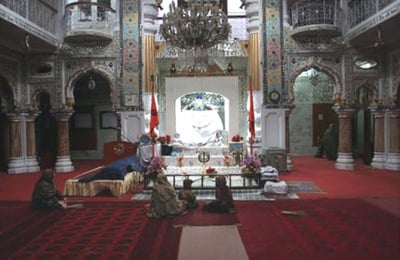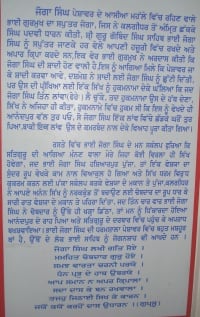Gurdwara Bhai Joga Singh (Peshawar): Difference between revisions
Allenwalla (talk | contribs) m (unclear if Sikh Taranjit Singh, was a Sikh named Taranjit Singh, who conducted interviews (of the locals) or if he was the local who was interviewed?) |
Allenwalla (talk | contribs) mNo edit summary |
||
| (2 intermediate revisions by the same user not shown) | |||
| Line 1: | Line 1: | ||
[[Image:Jogasingh.jpg|thumb|right| | [[Image:Jogasingh aw.jpg|thumb|400px|right|{{cs|'''Interior of Gurdwara Bhai Joga Singh, Peshawar'''}}]] | ||
'''Gurdwara Bhai Joga Singh''' is situated in Jogan Shah area of Namakmandi of Peshawar City. The Gurdwara, which was founded by [[Hari Singh Nalwa]] ([[Maharaja Ranjit Singh]]'s fabled General) when Peshawar was part of the Sikh Kingdom. It is named in honour of [[Bhai Joga Singh]], a young Gursikh who had lived in the presence of [[Guru Gobind Singh]] at Anandpur for many years. | '''Gurdwara Bhai Joga Singh''' is situated in Jogan Shah area of Namakmandi of Peshawar City. The Gurdwara, which was founded by [[Hari Singh Nalwa]] ([[Maharaja Ranjit Singh]]'s fabled General) when Peshawar was part of the Sikh Kingdom. It is named in honour of [[Bhai Joga Singh]], a young Gursikh who had lived in the presence of [[Guru Gobind Singh]] at Anandpur for many years. | ||
One day his parents, eager to see him married, arrived at Anandpur to escort him back to Peshawar. The Guru permitted him to depart, saying that he must return at once when recalled. Back in Peshawar Joga Singh was in the midst of his nuptials and had completed only two of the customary four circumambulations when a Sikh arrived and delivered the Guru's letter of recall. As the Guru had used the words, '''at once'', he left the ceremony midway, despite the many and loud protestations of his relatives, immediately setting out for [[Anandpur]]. | One day his parents, eager to see him married, arrived at Anandpur to escort him back to Peshawar. The Guru permitted him to depart, saying that he must return at once when recalled. Back in Peshawar Joga Singh was in the midst of his nuptials and had completed only two of the customary four circumambulations when a Sikh arrived and delivered the Guru's letter of recall. As the Guru had used the words, '' 'at once' '', he left the ceremony midway, despite the many and loud protestations of his relatives, immediately setting out for [[Anandpur]]. | ||
[[Image:Jogasingh3.JPG|thumb|200px|Gurdwara Bhai Joga Singh]] | [[Image:Jogasingh3.JPG|thumb|200px|Gurdwara Bhai Joga Singh]] | ||
==From an interview | ==From an interview with a Sikh named Taranjit Singh== | ||
Taranjit tells us about how this gurudwara came to be. “It was founded by Hari Singh Nalwah,” he says, “the general of Ranjit Singh’s army. [The Sikh empire once extended to Peshawar.] Hari Singh Nalwah was said to weigh 250 kgs. He was the strongest man in the universe. Once, he slapped a man and his head got dislocated from his shoulder. His chest was equal to that of seven people.” | |||
I am tempted to ask if he could fly when Taranjit continues: “No horse could carry his weight. Then one day a horse was found from Baluchistan that could carry his weight.” | |||
“Would you happen to know the name of that horse?” I ask. | |||
Taranjit looks at me oddly. “Horses don’t have names,” he says. | |||
(Apparently he had not heard the story of the two horses of the Guru that were taken back.) | |||
In the | “Anyway,” he continues, “Hari Singh Nalwah built around 2500 gurudwaras in Punjab, under the patronage of Maharaja Ranjit Singh.” | ||
“How many of these exist today?” | |||
“Maybe about 800,” he says. | |||
I (the interviewer is not named) find later that this figure is hearsay, it could be less, it could be more. Across the country, in fact, there are ex-gurudwaras that have been converted into schools, jails, homes and suchlike. The religion was almost wiped out when the partition of India took place. | |||
“All the Sikhs either shifted to India or went into the mountains,” says Taranjit. “Only recently have they started coming down from the mountains.” Peshawar has more Sikhs than any other city in Pakistan. Pushto is the mother tongue of most of them. | |||
Taranjit then introduces us to Sardar Shona Singh, the pramukh of the gurudwara. “This gurudwara was shut down in 1947,” Sardar Shona Singh says. “Then, in 1980, the Pakistan government gave us permission to start it again. It took us three days just to clean this place up.” | |||
In the mornings the Sangat of Peshawar, often joined by foreign sangats, is held and in the evening the Parakash of the Guru Granth Sahib takes place. | |||
==See also== | ==See also== | ||
* [[Gurdwara Bhai Joga Singh]], Hoshirpur | * [[Gurdwara Bhai Joga Singh]], Hoshirpur | ||
[[Category:Gurdwaras in Peshawar District]] | [[Category:Gurdwaras in Peshawar District]] | ||
Latest revision as of 06:47, 14 June 2010
Gurdwara Bhai Joga Singh is situated in Jogan Shah area of Namakmandi of Peshawar City. The Gurdwara, which was founded by Hari Singh Nalwa (Maharaja Ranjit Singh's fabled General) when Peshawar was part of the Sikh Kingdom. It is named in honour of Bhai Joga Singh, a young Gursikh who had lived in the presence of Guru Gobind Singh at Anandpur for many years.
One day his parents, eager to see him married, arrived at Anandpur to escort him back to Peshawar. The Guru permitted him to depart, saying that he must return at once when recalled. Back in Peshawar Joga Singh was in the midst of his nuptials and had completed only two of the customary four circumambulations when a Sikh arrived and delivered the Guru's letter of recall. As the Guru had used the words, 'at once' , he left the ceremony midway, despite the many and loud protestations of his relatives, immediately setting out for Anandpur.
From an interview with a Sikh named Taranjit Singh
Taranjit tells us about how this gurudwara came to be. “It was founded by Hari Singh Nalwah,” he says, “the general of Ranjit Singh’s army. [The Sikh empire once extended to Peshawar.] Hari Singh Nalwah was said to weigh 250 kgs. He was the strongest man in the universe. Once, he slapped a man and his head got dislocated from his shoulder. His chest was equal to that of seven people.”
I am tempted to ask if he could fly when Taranjit continues: “No horse could carry his weight. Then one day a horse was found from Baluchistan that could carry his weight.”
“Would you happen to know the name of that horse?” I ask.
Taranjit looks at me oddly. “Horses don’t have names,” he says.
(Apparently he had not heard the story of the two horses of the Guru that were taken back.)
“Anyway,” he continues, “Hari Singh Nalwah built around 2500 gurudwaras in Punjab, under the patronage of Maharaja Ranjit Singh.”
“How many of these exist today?”
“Maybe about 800,” he says.
I (the interviewer is not named) find later that this figure is hearsay, it could be less, it could be more. Across the country, in fact, there are ex-gurudwaras that have been converted into schools, jails, homes and suchlike. The religion was almost wiped out when the partition of India took place.
“All the Sikhs either shifted to India or went into the mountains,” says Taranjit. “Only recently have they started coming down from the mountains.” Peshawar has more Sikhs than any other city in Pakistan. Pushto is the mother tongue of most of them.
Taranjit then introduces us to Sardar Shona Singh, the pramukh of the gurudwara. “This gurudwara was shut down in 1947,” Sardar Shona Singh says. “Then, in 1980, the Pakistan government gave us permission to start it again. It took us three days just to clean this place up.”
In the mornings the Sangat of Peshawar, often joined by foreign sangats, is held and in the evening the Parakash of the Guru Granth Sahib takes place.
See also
- Gurdwara Bhai Joga Singh, Hoshirpur


